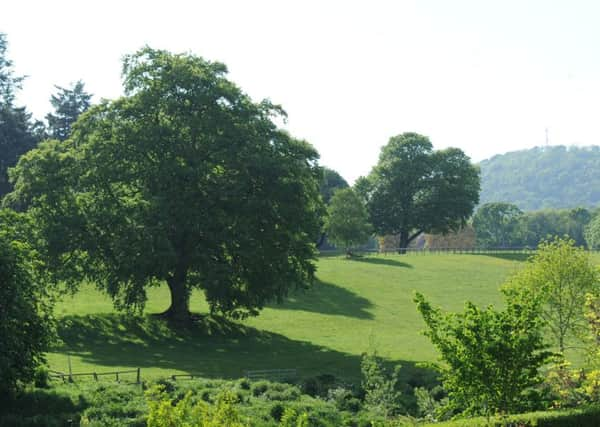Borders council chiefs accused of paying over odds for Tweedbank estate


The council has spent £9.6m on purchasing land to the south of the River Tweed with a view to building hundreds of houses and an industrial estate there.
Council officers believe that the site, as part of a wider Tweedbank development plan, will create 180 permanent jobs, and a similar number during the construction phase.
Advertisement
Hide AdAdvertisement
Hide AdThe site has also been earmarked for a 300-home housing estate.
At a full meeting of the council yesterday, December 20, its executive member for business and economic development, Mid-Berwickshire councillor Mark Rowley, told members: “This was a project set in motion by a previous council.
“In 2016, the previous council agreed to the purchase of Lowood in principle, and over the last few years, work has been developing on this.
“What makes this incredibly important, probably more important than it was in 2016, is that with all the talk around budgets, the council can no longer just sit back and try to carry on carrying out services.
“We need to take decisive and strategic action, and this is an incredibly bold, and good, large-scale development.
“It’s maximising benefits we’re already seeing with the Borders Railway. It strengthens the case, very strongly, for extending the railway to Carlisle, so I am incredibly supportive, as you’d expect. I think this helps us grow the Borders on to success.
“The stats sound almost academic and meaningless, but we’re talking about a development here of hundreds of jobs.
“That is a huge leap for the Borders, especially when these better, higher-paid jobs come in. It gives us a business space of a quality which we don’t currently have in the Borders, and it gives us control over a potentially fantastic housing site.
“This is positive and a good news story.”
Advertisement
Hide AdAdvertisement
Hide AdCouncil officers estimate that developing the estate would cost an extra £80m on top of the price of the land but would potentially generate £150m of gross value added for the region’s economy.
However, Tweeddale East councillor and opposition leader Stuart Bell claims the estate is valued at much less than the council paid for it.
Mr Bell also revealed that Scottish Government’s district valuation service, a body offering impartial advice on how public money is spent, also told the council the property was not worth what it has paid for it.
He told members: “The Lowood Estate acquisition, which we are undertaking by ourselves, remains a tortured tale.
“The £9.6m outlay, plus expenses, plus cost of maintaining the land and assets, plus the cost of borrowing, means we’ll need to sell it all for over £11m just to break even.
“Reports we have seen in private say there will also be significant infrastructure costs to develop the site.
“I don’t believe this site is worth £9.6m when you go into the detail of the terms and conditions of the sale, and that was the opinion of the district valuer, whose assessment with vacant possession, which we will not have, was much lower than £9.6m.
“Even when adjusted up for a special assumption, the district valuer still valued the land at a price lower than we are paying.
Advertisement
Hide AdAdvertisement
Hide Ad“This is a speculative and risky expenditure of public money at a time when, quite apart from Brexit, there is shuddering uncertainty in markets.
“House prices and land values can go down as well as up. We should not be spending public money on buying this estate at this time for more than it is worth.
“In what alternative opportunities could we invest £10m?
“This council should invest enough in roads to significantly improve the road condition index, but we cannot afford to do that.
“This council should commit to four new high schools in 10 years, but you won’t make that commitment.
“I will not tell the electors in Peebles, as you will have to, that they cannot have a new high school within 10 years when you have tied up £10m for 10 or so years in Tweedbank.
“We can’t even cut the grass properly in our cemeteries, but this administration glibly spends £10m on buying a private estate.
“This is a decision I fear you may come to regret.”
In reply, East Berwickshire councillor Jim Fullarton defended the deal, claiming that pressures on local government spending made such projects necessary, saying: “We’ve had several briefings on this subject, and officers have presented us with an excellent paper on the future benefits of developing this site, especially with the council in control.
“Now councillor Bell is scaremongering about service cuts, but this is a smokescreen to keep us away from the real issue at hand, which is the financial pressure being passed down to Scottish local authorities by his SNP colleagues.
Advertisement
Hide AdAdvertisement
Hide Ad“Scottish local councils are currently expected to continue services while facing continuous cuts.
“It will be very interesting to see what opposition councillors bring to the table for their budget proposals. No doubt there will be some vanity projects.”
The Tweedbank masterplan, going hand in hand with the Borders Railway blueprint programme, includes earmarking residential and business space on the estate, as well as expanding Tweedbank and rebranding the current industrial estate there as the Borders Innovation Park.
The deal agreed with the estate’s owner, Alexander Hamilton, is for the remaining 110 acres still in private hands to add to the 190 acres bought from then owner Constance Hamilton using compulsory powers by the former Roxburgh County Council in the early 1970s to create Tweedbank.
The land will now be owned by Lowood Tweedbank, a company set up and owned by the council.